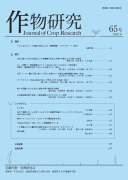Current issue
Displaying 1-8 of 8 articles from this issue
- |<
- <
- 1
- >
- >|
-
2023 Volume 68 Pages 1-6
Published: June 21, 2023
Released on J-STAGE: December 25, 2023
Download PDF (3196K) -
2023 Volume 68 Pages 7-13
Published: June 21, 2023
Released on J-STAGE: December 25, 2023
Download PDF (10717K) -
2023 Volume 68 Pages 15-23
Published: June 21, 2023
Released on J-STAGE: December 25, 2023
Download PDF (2326K) -
2023 Volume 68 Pages 25-29
Published: June 21, 2023
Released on J-STAGE: December 25, 2023
Download PDF (3940K) -
2023 Volume 68 Pages 31-39
Published: June 21, 2023
Released on J-STAGE: December 25, 2023
Download PDF (4434K) -
2023 Volume 68 Pages 41-50
Published: June 21, 2023
Released on J-STAGE: December 25, 2023
Download PDF (8631K) -
2023 Volume 68 Pages 51-60
Published: June 21, 2023
Released on J-STAGE: December 25, 2023
Download PDF (7640K) -
2023 Volume 68 Pages 61-64
Published: June 21, 2023
Released on J-STAGE: December 25, 2023
Download PDF (1432K)
- |<
- <
- 1
- >
- >|
